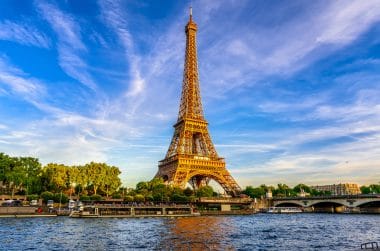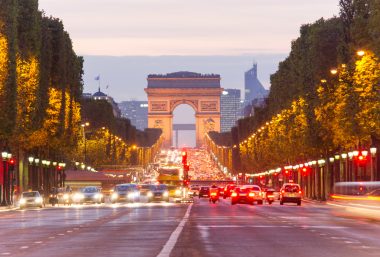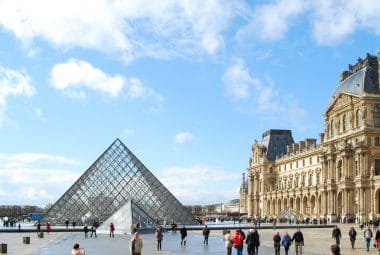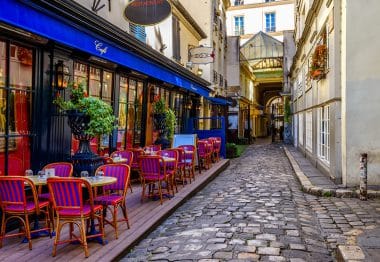The French capital Paris is one of the most popular travel destinations in the world. It is also called the City of Light and is known for its fascinating flair and joie de vivre. Paris was founded more than 2000 years ago under the name Lutetia. Today, the vibrant metropolis, which has a population of around 2.2 million, is known for culture, art and fashion.
Couples in love stroll along the Seine or enjoy the intoxicating atmosphere in the small side streets with their cafés. Paris is the most visited city in the world and can count over 16 million tourists every year. The number of tourists is well distributed among the 20 arrondissements. The districts have been arranged in a spiral pattern since the 19th century, with the low numbers being found in the city centre and the highest digits being the outskirts.
Paris – City on the Seine
The Seine plays an important role for Paris. The river divides the city into two areas. While the right bank of the Seine is home to commercial enterprises, the economy and numerous shopping districts, the cultural highlights, the literary cafes and the universities are located on the left bank. A visit to Paris is particularly suitable for people who love pleasure. There are a variety of cafés, restaurants and magnificent boulevards. In addition, the French capital is characterized by its cultural diversity.
Visit and experience Paris
A trip to Paris is suitable for both young and old. Families with children get their money’s worth there as well as couples who have just fallen in love. The city offers wonderful sights, monuments, museums, art galleries and parks. Shopping in Paris is also considered an experience. Just like large department stores, many small shops can be found in the city.
How to get to Paris
Paris can be easily reached via the two major airports Charles de Gaulle and Orly. From there, there are connections to the city center. As a central transport hub of France , Paris is of course also accessible by train. The metropolis has seven large train stations that lead in all directions. There are also numerous bus connections.
Within Paris, the Metro, which includes 16 lines, offers a good opportunity to get around the city quickly. If you want to travel further into the surrounding area, you can use the RER A-E rapid transit train.
The districts of Paris
Paris is made up of 20 arrondissements. Because the districts are arranged in the shape of a spiral, they are also known as the “Parisian snail shell” (l ́Escargot de Paris). In the center of this snail is the historic city center, which can offer many interesting sights. There are numerous historical buildings there.
An arrondissement, in turn, is divided into four quarters (quartiers). The most beautiful Parisian districts are the Seine island Ile de la Cite, the Latin Quarter, Saint-Germain des Prés and Montmartre.
The sights of Paris
Paris has a considerable number of sights of all kinds . In order to be able to take a look at most of them, you should bring enough time for the city visit. On a tour of the metropolis, it should be borne in mind that many sights close again at 5 p.m. Therefore, it is advisable to start the sightseeing tour as early as possible. But in the end, the visit is worth it.
The Eiffel Tower

One of the most important landmarks of Paris is undoubtedly the Eiffel Tower on the southern bank of the Seine. From there, the city can be overlooked excellently. The Eiffel Tower, built in 1889 by Gustave Eiffel, reaches a height of 324 meters. It has three viewing platforms at a height of 57, 115 and 274 meters. Every year, about seven million people are guests on the tower.
A visit to the Eiffel Tower is particularly beautiful in the evening, when the lights shine in their splendour. It’s not for nothing that Paris is also known as the city of romance.
The Field of Mars
After a visit to the Eiffel Tower, you can take a stroll through the neighbouring Champs du Mars. From time to time, concerts are also held there.
Notre-Dame Cathedral
Another defining landmark of the French metropolis is the Notre-Dame de Paris Cathedral on the city island of Ile de la Cité. Translated, the name means “Our Lady of Paris”. The construction of the Gothic church building took place between 1163 and 1345. The two towers of the church, which reach a height of 69 meters, are particularly memorable. The building is considered the most important cathedral in all of Europe. In 1804, Napoleon Bonaparte crowned himself emperor there. The fantastic building also gained great fame through the novel “The Hunchback of Notre-Dame” by Victor Hugo.
The nave reaches a length of 130 meters and a height of 35 meters. Up to 9000 people can be accommodated at the services. From the towers there is a magnificent view of Paris.
Important information about Notre Dame Cathedral: Due to the fire of the cathedral in 2019, a visit to this attraction is unfortunately not possible. The restoration will most likely last until 2024.
A visit to the Ile de la Cité
But Notre-Dame Cathedral is not the only attraction on the Ile de la Cité. Also worth a detour are today’s Palace of Justice and former royal residence Palais de la Cité, the Conciergerie, the Place Dauphine with the monument to King Henry IV, and the High Gothic former palace chapel Saint-Chapelle from the 13th century.
Take a boat tour on the Seine
A good way to discover Paris in more detail is to take a boat tour on the Seine. From the river, you can see many of the city’s major attractions, such as Notre-Dame, the Eiffel Tower, the National Assembly or the Musée d ́Orsay. A stroll along the banks of the Seine is also highly recommended.
The Arc de Triomphe

Ioan Panaite / shutterstock
The Arc de Triomphe in Paris is also one of the city’s most famous sights. It is located between the Champs-Élysées and La Defénse. It forms part of the Louvre – Place de la Concorde – La Defénse axis. A total of twelve roads lead to the Arc de Triomphe.
The Arc de Triomphe was commissioned by Emperor Napoleon I in 1806 to commemorate the French victories. However, it took until 1836 for the building to be completed. Its features include the figures and reliefs that focus on the French Revolution. The triumphal arch reaches a height of 49.5 metres and a width of 44.8 metres.
On the upper part of the Arc de Triomphe there is a viewing terrace from which you can have a wonderful view of the surroundings. There is also a museum below the platform that provides interesting information about the construction of the Arc de Triomphe.
Champs Elysées
The Champs Elysées is considered the city’s boulevard and leads up to the Arc de Triomphe de l’Étoile. The Arc de Triomphe is often confused with the smaller model at the Louvre, which was also built under the direction of Napoleon. The Arc de Triomphe is located in the middle of a large roundabout and is the destination of the Tour de France, which runs through the whole of France every summer. Paris is always the end point and chooses the winner of the tour. The Arc de Triomphe can be reached via an underground tour. There is a grave of an unknown soldier who died in the First World War. The Eternal Flame is rekindled daily by soldiers. It is intended to commemorate all the unknown victims of the First World War. Fresh flowers are always around the grave. A climb is not free, but it offers a fantastic view of the Champs Elysée.
https://youtu.be/AhCnrFOQAi4?si=yX_I_yIP0QYGjaab
Visit the Louvre

A popular visitor attraction of Paris is the Louvre Museum of Art, which is housed in the Palais de Louvre, the former residence of the French monarchs. It is one of the largest museums in the world. Due to its enormous scale, a day visit is often not enough for a closer inspection.
The Louvre is home to more than 35,000 exhibits, including works by the great European masters, Greek and Roman collections from antiquity, Renaissance paintings, and works by Dutch and French painters.
Particularly well-known exhibits in the Louvre that visitors should definitely see are Leonardo da Vinci’s Mona Lisa, the Venus de Milo and Liberty Leading the People by Eugène Delacroix.
Europeans who have not yet reached the age of 25 can see the Louvre and other sights for free.
Discover the charm of old Paris in Montmartre
Montmartre is the name given to the 18th district of Paris, which is located in the north of the metropolis. Translated, Montmartre means “martyr’s hill”. At 130 metres, it is the highest natural elevation in Paris. The quarter is one of the most popular visitor magnets in the French capital.
The symbol of Montmartre is the Basilica of the Sacré-Coeur, which rises on the top of the hill. The district takes visitors partly into the Belle Epoque. There are numerous small cafés, restaurants and pubs that invite you to visit. The winding alleys and streets are also reminiscent of old Paris. In addition, Montmartre is also considered an artists’ district.
The Invalides
In the 7th arrondissement is the Invalides. The domed building belongs to the war invalids’ home and has served as Napoleon Bonaparte’s burial place since 1840. In the Invalides, built between 1679 and 1708, there are other graves of high-ranking French military figures.
Excursions outside the city
If you leave the city, you can pay a visit to Disneyland or the Palace of Versailles. Both are easy to reach by car, but also by train. The Palace of Versailles was built by Louis XIV. Historical events took place in the Hall of Mirrors and the spacious garden is worth a walk.
Shopping in Paris
Paris offers excellent opportunities for shopping. Shops and shopping malls are in abundance. Shopping enthusiasts can visit the Forum des Halles, one of the most popular shopping centres in Paris, the large Le Quartre Temps shopping mall and the modern Beaugrenelle shopping centre.
Also worth a detour is the Galeries Lafayette department store with its imposing dome. Fashion lovers in particular will get their money’s worth there. If you like branded and luxury goods, you will find everything your heart desires on the Champs-Élysées, the Parisian boulevard.
You can browse at your leisure at the Marché aux Puces Saint Quen, the largest flea market in Paris. There is always something to discover at the many stalls.
Stade de France
The Stade de France is located in St. Denis, a suburb of Paris, and serves as a venue for various sports such as football or cycling. It can accommodate up to 82,000 spectators. The Stade de France can be reached in a few minutes by metro. The Saint-Denis district is another of the city’s attractions that few tourists know about. The Cathedral of Saint-Denis is considered one of the oldest churches in the country and one of the first Gothic churches ever, built in 1135. Until the Middle Ages, the cathedral was the burial place of many kings.
The most important facts about Paris
-

Typical small Parisian street with many small cafes, Image: Catarina Belova / shutterstock Foundation and history: Paris was founded in the 3rd century BC. founded by a Celtic tribe called Parisii. The city has a rich history and played a central role in the French Revolution, as well as many other significant historical events in Europe.
- Geographical location: Paris is located in the north of central France on the Seine River. The city is known for its picturesque streets and historic bridges over the Seine.
- Population: Paris has a population of over 2 million people in the administrative urban area and over 12 million in the entire metropolitan area.
- Culture and sights:
- The Eiffel Tower, the world-famous landmark of Paris, attracts millions of visitors every year.
- The Louvre, one of the largest and most famous art museums in the world.
- Notre-Dame Cathedral, a masterpiece of Gothic architecture.
- Sacré-Cœur, a basilica on Montmartre hill, offers one of the best views of the city.
- The Champs-Élysées, known for its shops, theaters and cafes.
- Economy: Paris is a major international center for art, fashion, gastronomy and culture. It is also an important financial and business center in Europe.
- Transport: Paris has an extensive public transport system, ranging from the Paris metro, buses and trams to extensive bike rental and car-sharing services.
- Education and research: Paris is home to some of the world’s leading educational and research institutions, including the Sorbonne and the Collège de France.
- Gastronomy: The city is famous for its gastronomy, from haute cuisine in Michelin-starred restaurants to traditional bistros and bakeries.
- Fashion: Paris is considered one of the fashion capitals of the world, with major fashion events such as Paris Fashion Week.


